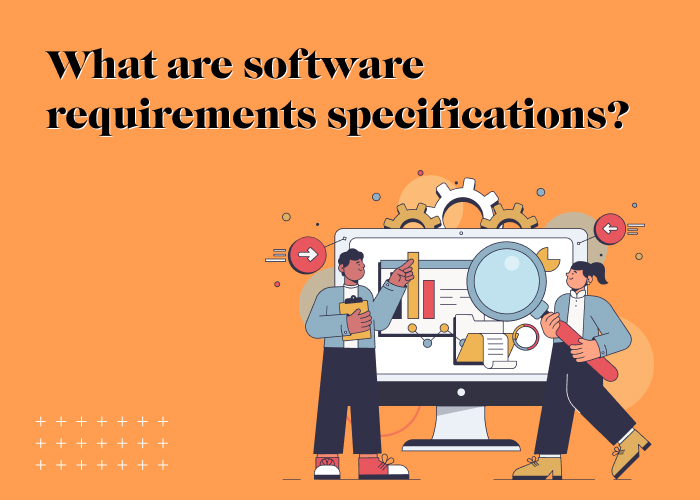What are software requirements specifications?

A software project’s interfaces, features, limitations, and system requirements are all thoroughly described in the software requirements specifications. Now, what is SRS in software? An SRS document essentially serves as a channel between the development team’s understanding of what has to be created and the client’s expectations. It acts as a roadmap that directs the whole process of developing software, from idea to completion.
What is included in the SRS document?
Below are the points included in the SRS document:
- Project’s scope: This establishes boundaries for the development team by outlining what the software system will and will not perform.
- Project needs: A SRS notifies developers, testers, project managers, and clients of both the functional and non-functional requirements of the product.
- Planning and estimation: SRS aids in estimating the time, money, and resources required for development by offering a thorough explanation of the project needs.
- Cooperation: Generally, the development team and the client work together to create the SRS document. It assists in making sure that everyone is aware of the goals, features, and limitations of the project.
- Validation and verification: During the development phase, the software requirements specifications document is used to confirm that all criteria have been met and to validate that the supplied software satisfies the specifications.
How to write a software requirements specification document?
It is not a tough task to create a software requirements specifications document. Below is the detailed process:
- Outlining the document: Outline the introduction, general description, and features and requirements.
- Defining purpose: Actually, the SRS document is summarized in this part. It enables you to clearly define the features and functions you want your product to have. Thus, you should go into great depth about your target market here, as well as how they will utilize your product and what benefits it will offer.
- Giving overview: Here you can elaborate on the project’s concept and discuss it with the people. Explain every feature and function, along with how it will meet the needs of the user. You can also draw attention to any presumptions regarding the functionality of the product. Remember to discuss the unique features that set your product apart from the competition and make sure you do it in a clear and concise manner.
- Add supplementary ideas: You can use this space to indicate areas where your development team may be creative and flexible as well as to establish priority for certain features. Remember that the program will perform better and satisfy your expectations if you provide more facts.
What are the mistakes to avoid in the SRS document?
First, watch your language to avoid giving anything away. Keep in mind that the purpose of a software requirements specification is to avoid misunderstandings, so make sure your needs are clear. Give each feature a precise explanation, and stay away from using terms that have more than one meaning.
Secondly, try not to make your paper too complicated. The wording in your paper should be standardized; this is not a huge concern. Just keep it simple and explain the terms before you use them. Utilizing references like “as shown in” or “in accordance with” might also be beneficial.
Conclusion
As we draw to a close of this thorough overview of software requirements specification, it’s critical to emphasize the role that this document plays in determining how software projects proceed. Organizations may use the power of SRS to create successful results and provide software solutions that meet or exceed expectations by following best practices, encouraging collaboration, and keeping flexibility to accept changes.
FAQs
Why is Software Requirements Specification important?
Software Requirements Specifications are crucial because they define the scope, functionalities, and constraints of a software project, ensuring alignment between stakeholders and developers, guiding estimation and planning, and serving as a reference for validation and verification.
Who creates the SRS?
The SRS document is typically a collaborative effort between the client, stakeholders, and the development team. Project managers, business analysts, system architects, and subject matter experts are often involved in its creation.
What should be included in a SRS?
An SRS should include a detailed description of functional and non-functional requirements, system interfaces, user interfaces, performance requirements, design constraints, and acceptance criteria, among other key elements.
How often should the Software Requirements Specification be updated?
The SRS should be updated throughout the software development lifecycle to reflect changes in requirements, scope, or project constraints. Regular reviews and updates ensure that the document remains relevant and accurate.
What happens if there are discrepancies or changes in the Software Requirements Specification?
Discrepancies or changes in the SRS should be addressed through a formal change management process. This involves documenting proposed changes, assessing their impact on the project, obtaining approval from stakeholders, and updating the SRS accordingly.
Ravi Bhojani is the Chief Marketing Officer (CMO) at Alian Software, where he spearheads the company’s marketing strategies and drives its brand presence in the competitive IT services landscape. With over a decade of experience in the technology and marketing sectors, Ravi has consistently demonstrated his ability to blend innovative marketing techniques with deep industry knowledge to deliver outstanding results.